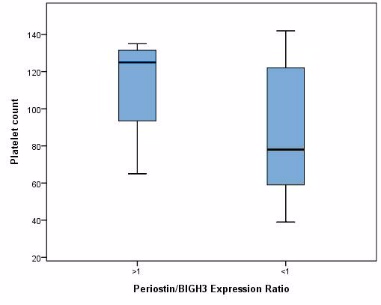
Contributions
Abstract: PB1857
Type: Publication Only
Background
Disrupted hematopoiesis is life-threatening complication of allogeneic hematopoetic cell transplantation (allo-HCT). The interactions of haematopoietic stem/ progenitor cells (HSPCs) and bone marrow (BM) microenvironment, niche(s), control the homeostasis of BM. TGF-b induced gene 3 (BIGH3), one of BM extracellular matrix (ECM) which is produced by niche cells maintain the homeostasis and regeneration of BM.
Aims
We analyzed the relationship between the idiopathic thrombocytopenia after allo-HCT and the BM expression of periostin as the only paralogue of BIGH3.
Methods
We reviewed twenty patients who transplanted with matched sibling donor for acute myelogenous leukemia at Kyungpook National University Hospital from January 2010 to August 2015. BM biopsy specimens at the time of day 28, day 90, day 180, day 365 since allo-HCT were decalcified and stained with primary antibody of BIGJ3 and periostin. Expression of periostin in BM slides were reviewed by pathologist as follows; normal (0), minimal staining around blood vessels; (+1), sparse staining and/or focally staining; (+3), diffuse and strong staining; (+2), between (0) and (+3).
Results
The median age at transplant was 38.5 years (range, 17-68 years) and male was 13 patients (65%). Twelve patients (60%) were in CR1 (complete remission), 8 (40%) in CR2. Thirteen patients (65%) received myeloablative conditioning regimen. The median dose of CD34+ cell was 3.87×106/kg (range, 1.6~7.67×106/kg). All patients achieved the neutrophil engraftment with a median time of 13 days (range 9-24days). The median time of platelet engraftment was 15.5 days (range, 13-77days). Idioathic thrombocytopenia developed as follows; 13 patients at day 28, 16 at day 90, 6 at day 180, and 3 at day 365. There was no significant difference between idiopathic thrombocytopenia and the expression of BIGH3 or Periostin (p=0.128) However, BM with thrombocytopenia manifested the low periostin/BIGH3 ratio (p=0.007). Acute GVHD was observed in 12 patients (60%) and chronic GVHD developed in 13 patients (65%). The developemnet of thrombocytopenia dose not differ according to acute and chronic GVHD (p=0.847)

Conclusion
The periostin/BIGH3 might represent the status of BM niche during the homeostasis and regeneration of hematopoiesis. High periostin/BIGH3 ratio could predict the recovery of the idiopathic thrombocytopenia.
Session topic: 23. Hematopoiesis, stem cells and microenvironment
Keyword(s): Transplant, Thrombocytopenia, Microenvironment, Acute Myeloid Leukemia
Abstract: PB1857
Type: Publication Only
Background
Disrupted hematopoiesis is life-threatening complication of allogeneic hematopoetic cell transplantation (allo-HCT). The interactions of haematopoietic stem/ progenitor cells (HSPCs) and bone marrow (BM) microenvironment, niche(s), control the homeostasis of BM. TGF-b induced gene 3 (BIGH3), one of BM extracellular matrix (ECM) which is produced by niche cells maintain the homeostasis and regeneration of BM.
Aims
We analyzed the relationship between the idiopathic thrombocytopenia after allo-HCT and the BM expression of periostin as the only paralogue of BIGH3.
Methods
We reviewed twenty patients who transplanted with matched sibling donor for acute myelogenous leukemia at Kyungpook National University Hospital from January 2010 to August 2015. BM biopsy specimens at the time of day 28, day 90, day 180, day 365 since allo-HCT were decalcified and stained with primary antibody of BIGJ3 and periostin. Expression of periostin in BM slides were reviewed by pathologist as follows; normal (0), minimal staining around blood vessels; (+1), sparse staining and/or focally staining; (+3), diffuse and strong staining; (+2), between (0) and (+3).
Results
The median age at transplant was 38.5 years (range, 17-68 years) and male was 13 patients (65%). Twelve patients (60%) were in CR1 (complete remission), 8 (40%) in CR2. Thirteen patients (65%) received myeloablative conditioning regimen. The median dose of CD34+ cell was 3.87×106/kg (range, 1.6~7.67×106/kg). All patients achieved the neutrophil engraftment with a median time of 13 days (range 9-24days). The median time of platelet engraftment was 15.5 days (range, 13-77days). Idioathic thrombocytopenia developed as follows; 13 patients at day 28, 16 at day 90, 6 at day 180, and 3 at day 365. There was no significant difference between idiopathic thrombocytopenia and the expression of BIGH3 or Periostin (p=0.128) However, BM with thrombocytopenia manifested the low periostin/BIGH3 ratio (p=0.007). Acute GVHD was observed in 12 patients (60%) and chronic GVHD developed in 13 patients (65%). The developemnet of thrombocytopenia dose not differ according to acute and chronic GVHD (p=0.847)

Conclusion
The periostin/BIGH3 might represent the status of BM niche during the homeostasis and regeneration of hematopoiesis. High periostin/BIGH3 ratio could predict the recovery of the idiopathic thrombocytopenia.
Session topic: 23. Hematopoiesis, stem cells and microenvironment
Keyword(s): Transplant, Thrombocytopenia, Microenvironment, Acute Myeloid Leukemia


